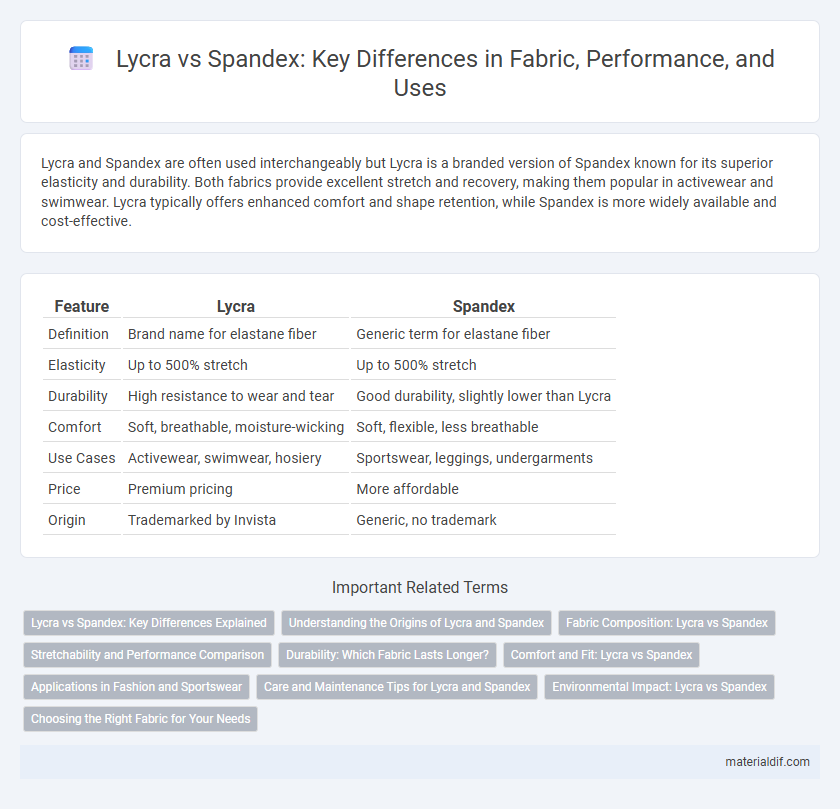Lycra and Spandex are often used interchangeably but Lycra is a branded version of Spandex known for its superior elasticity and durability. Both fabrics provide excellent stretch and recovery, making them popular in activewear and swimwear. Lycra typically offers enhanced comfort and shape retention, while Spandex is more widely available and cost-effective.
Table of Comparison
| Feature | Lycra | Spandex |
|---|---|---|
| Definition | Brand name for elastane fiber | Generic term for elastane fiber |
| Elasticity | Up to 500% stretch | Up to 500% stretch |
| Durability | High resistance to wear and tear | Good durability, slightly lower than Lycra |
| Comfort | Soft, breathable, moisture-wicking | Soft, flexible, less breathable |
| Use Cases | Activewear, swimwear, hosiery | Sportswear, leggings, undergarments |
| Price | Premium pricing | More affordable |
| Origin | Trademarked by Invista | Generic, no trademark |
Lycra vs Spandex: Key Differences Explained
Lycra and Spandex are often used interchangeably, but Lycra is a branded type of Spandex known for its superior elasticity and durability, primarily manufactured by Invista. Spandex refers to the general category of synthetic fibers made from polyurethane, characterized by exceptional stretch and recovery properties. Key differences include Lycra's enhanced resistance to chlorine and UV rays, making it a preferred choice in performance athletic wear, while generic Spandex offers a broader range of applications at a lower cost.
Understanding the Origins of Lycra and Spandex
Lycra and spandex both refer to the same synthetic fiber known for its exceptional elasticity, with Lycra being a brand name trademarked by DuPont. Spandex originated in the late 1950s as a revolutionary alternative to rubber, designed to provide greater stretch and durability for activewear and performance fabrics. Understanding the origins of these fabrics highlights their significance in modern textiles, offering enhanced comfort, flexibility, and shape retention in apparel.
Fabric Composition: Lycra vs Spandex
Lycra and spandex are both synthetic fibers known for their exceptional elasticity, composed primarily of polyurethane segments. Lycra is a trademarked brand of elastane, often blended with cotton, polyester, or nylon to enhance stretch and comfort in activewear and hosiery. Spandex, a generic term, shares a similar chemical structure but is used more broadly across various fabric blends in sportswear and performance garments.
Stretchability and Performance Comparison
Lycra and Spandex both offer exceptional stretchability, with Lycra providing superior elasticity up to 600% of its original length, enhancing comfort and freedom of movement in activewear and performance fabrics. Spandex, while slightly less elastic, maintains excellent shape retention and durability under repeated stretching, making it ideal for high-performance applications. The performance comparison reveals Lycra's edge in softness and resistance to sagging, whereas Spandex excels in resilience and cost-effectiveness.
Durability: Which Fabric Lasts Longer?
Lycra and Spandex are essentially the same material, both composed of polyurethane fibers known for exceptional elasticity and durability. The durability of these fabrics depends largely on the manufacturing quality and fabric blend rather than inherent differences, as Lycra is a brand name for a type of Spandex. Proper care, such as avoiding heat and harsh chemicals, extends the lifespan of both fabrics, with high-quality blends lasting several years without significant loss of stretch or strength.
Comfort and Fit: Lycra vs Spandex
Lycra, a brand name for a type of spandex, offers superior elasticity and shape retention, providing a comfortable, snug fit ideal for activewear and form-fitting garments. Spandex fibers are known for their excellent stretchability, allowing fabrics to move with the body while maintaining breathability and softness. Comfort and fit in Lycra-infused fabrics often surpass generic spandex blends due to advanced fiber technology enhancing durability and moisture-wicking properties.
Applications in Fashion and Sportswear
Lycra and Spandex are both elastane fibers widely used in fashion and sportswear for their exceptional stretch and recovery properties. Lycra, a branded form of Spandex, offers superior durability and retains shape better, making it ideal for high-performance sportswear such as compression garments and activewear. Spandex, often found in budget-friendly fashion, provides comfortable stretch in everyday clothing like leggings, swimwear, and stretchy denim.
Care and Maintenance Tips for Lycra and Spandex
Lycra and Spandex require gentle care to maintain elasticity and fabric integrity, including hand washing in cold water and avoiding bleach or fabric softeners. Both fabrics should be air-dried away from direct sunlight to prevent fiber damage and loss of stretch. Storing garments flat or hanging them properly helps preserve the shape and performance of Lycra and Spandex fabrics.
Environmental Impact: Lycra vs Spandex
Lycra and spandex are essentially the same type of elastane fiber, with negligible differences in environmental impact during production. Both materials are synthetic polyurethanes, derived from petrochemicals, contributing to non-renewable resource depletion and releasing harmful emissions in manufacturing. Efforts to improve sustainability focus on recycling processes and bio-based alternatives rather than distinguishing between Lycra and spandex specifically.
Choosing the Right Fabric for Your Needs
Lycra and spandex are both synthetic fibers known for their exceptional elasticity and are commonly used in activewear and shapewear. Lycra, a trademarked brand of spandex, often offers higher durability and better moisture-wicking properties, making it ideal for high-performance sports apparel. Choosing between Lycra and generic spandex depends on factors like fabric longevity, stretch recovery, and breathability tailored to your specific activity or garment requirements.
Lycra vs Spandex Infographic

 materialdif.com
materialdif.com